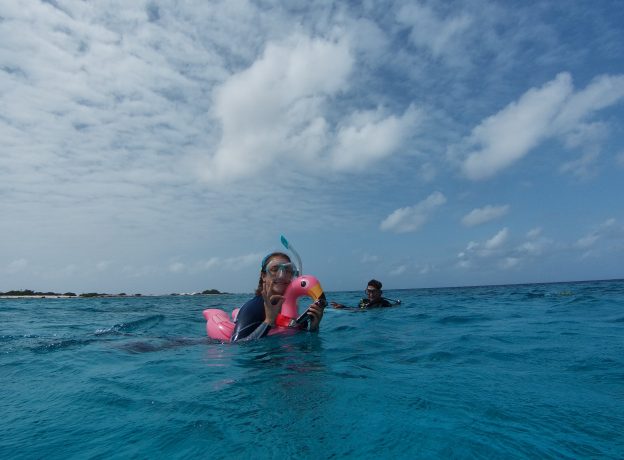As the 2021 American Academy of Underwater Sciences (AAUS) Mitchell Scientific Diving Intern for the Our World Underwater Scholarship Society (OWUSS), I will be assisting Ph.D. candidate Josh Manning with his dissertation research, along with other members of the McCoy Lab at Florida State University, Ph.D. candidate Ethan Cissell and undergraduate student Lena Kury! Josh’s research focuses on how parrotfish territoriality affects patterns of grazing intensity on the coral reefs of Bonaire. Parrotfishes are important grazers that use their beak-like teeth to scrape at the substrate, which helps to keep algae in check and creates bare space for juvenile corals to settle and grow. After several field seasons on the reefs of Bonaire, Josh noticed that males of some species, particularly the stoplight parrotfish Sparisoma viride, swim within well-defined territories and will chase off other males that enter these areas. This summer, we are recording the behaviors of several parrotfish species to better understand how these territories are defended and how they influence other aspects of parrotfish behavior.
After countless Zoom meetings working out travel logistics during a pandemic, three flights, multiple Covid-19 tests, and one last quarantine on Bonaire, our team was finally cleared to start conducting research! During our first few days of diving, we explored a few dive sites on the Northern leeward coast of the island, familiarized ourselves with everyone’s equipment, and ensured that we were weighted correctly so that we could practice proper buoyancy. As we descended onto the reef at Karpata, a historically well-studied site, I was instantly overwhelmed by the diverse species of corals thriving on the reef! With reef-building coral species like Orbicella annularis providing small hiding spaces for creatures of all sizes, it was not surprising to see a diverse assemblage of fish species. We were even lucky enough to find a green sea turtle, resting on top of soft corals!
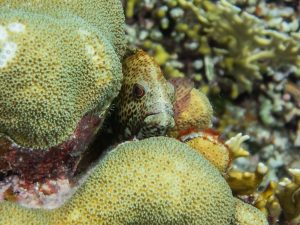
A graysby rests on Orbicella annularis, a foundational species of coral found on the reefs of Bonaire.
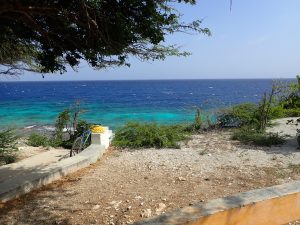
The view from the entry point at a popular dive site, Karpata.
After everyone felt comfortable in the water, it was time to get to work! A large portion of Josh’s research involves observing parrotfish behaviors, so we spent the next day practicing our fish identification skills! Parrotfishes are protogynous hermaphrodites that transition from an initial female phase to a terminal male phase based on social cues. These phases can have incredibly distinct colorations, so it is important to be able to differentiate when fishes are the opposite sex, or an entirely different species! While we will mostly be following terminal phase males this summer, it is important that we can also identify initial phase fish within each territory. This may help us to understand if males defend their territories from neighboring fishes to protect their preferred grazing spots, their mating opportunities, or a combination of the two!
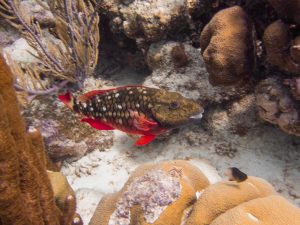
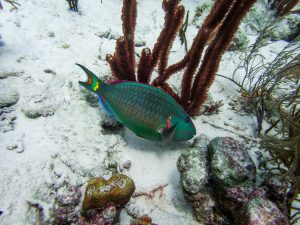
Stoplight parrotfish coloration changes drastically from the initial phase female (top photo) to the terminal phase male (bottom photo).
On our first day of data collection, we dove at one of Josh’s predetermined study sites, Invisibles, to record the behaviors of the stoplight parrotfish S. viride. During these dives, Josh identified a fish to observe for 30 minutes, while Ethan and I counted the number of initial phase fishes present within its territory. Josh would then signal to Lena, who was snorkeling at the surface with a handheld GPS receiver, to begin tracking the movements of the fish. At first, it was really difficult to determine how many initial phase fish were in each territory – if only they would just stay still! This became easier with time, and soon I was able to enjoy watching the fish from afar as they were grazing the reef substrate, visiting cleaning stations, and defending their territories from intruders.
After a few days at Invisibles, we moved on to tracking S. viride at our second dive site, Aquarius. This time, I was in charge of GPS tracking as the top-side snorkeler. Viewing these fish from above made it much easier to discern the boundaries of each territory, and when intruding fish were attempting to sneak into the territories. While it is tricky to keep up with a fish that is chasing another male out of its territory, especially when swimming against the winds on top of a flotation device, it has become my favorite part of tracking the stoplight parrotfish! These chases help us determine the true boundaries of each fish’s territory, so that we can better understand the impacts of their grazing!
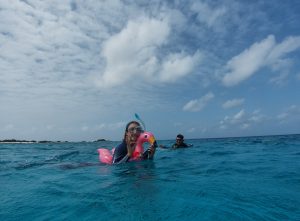
While Josh observes parrotfish behavior underwater, I snorkel with a GPS receiver to record fish movement and identify territory boundaries.
Photo credit: Lena Kury

